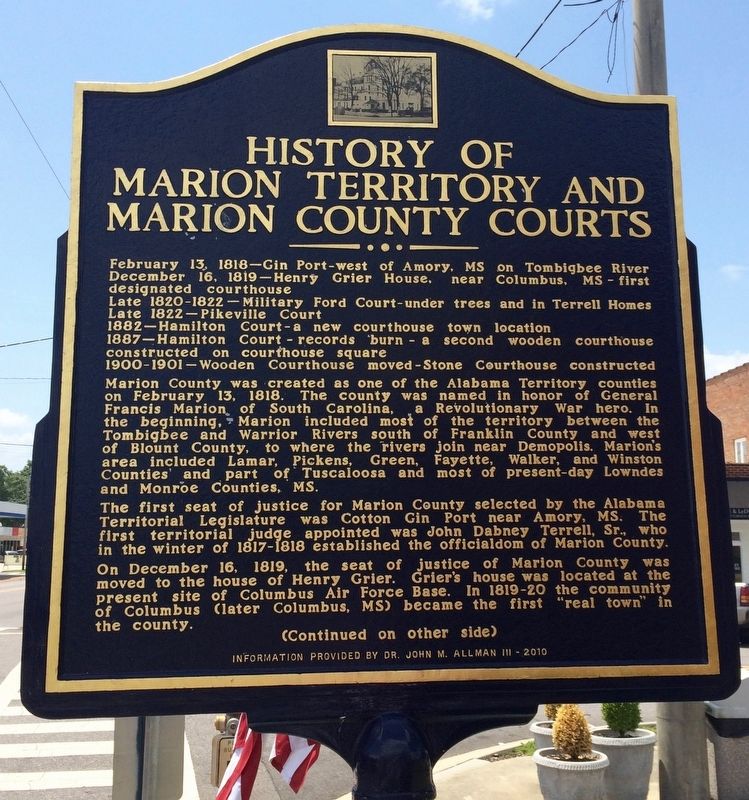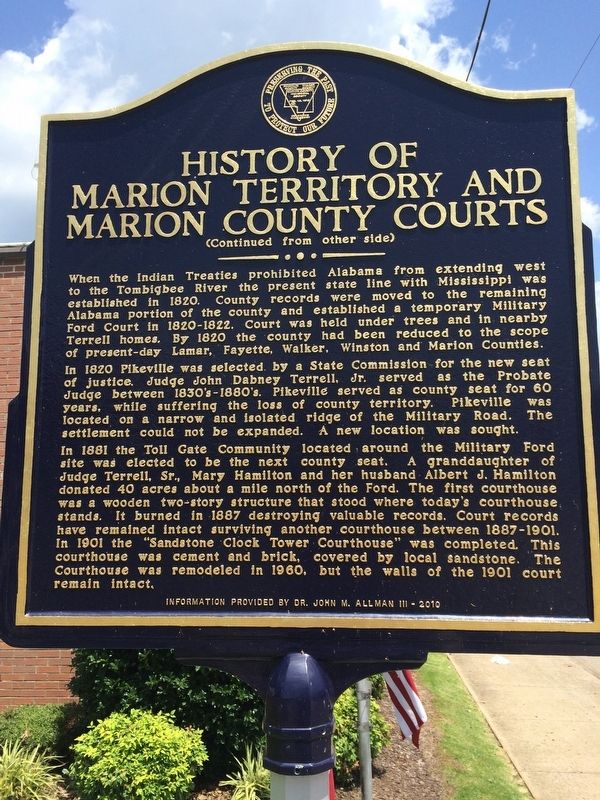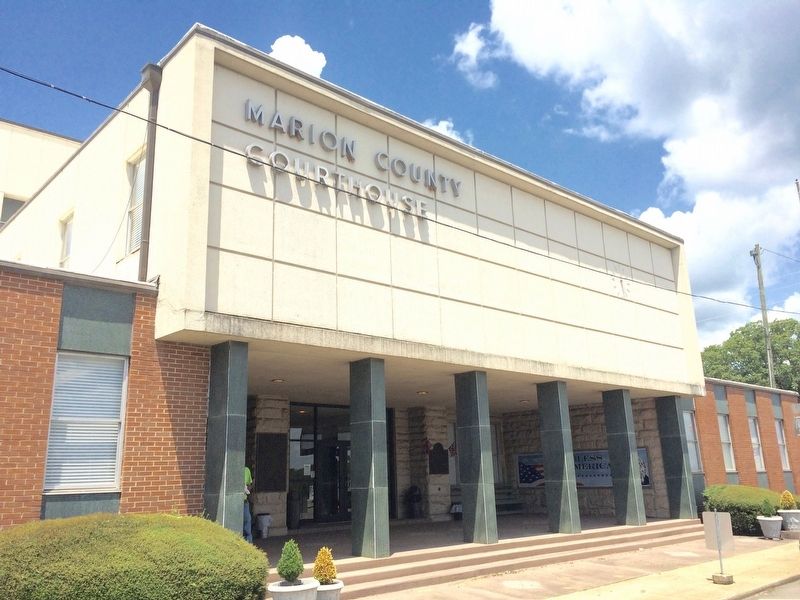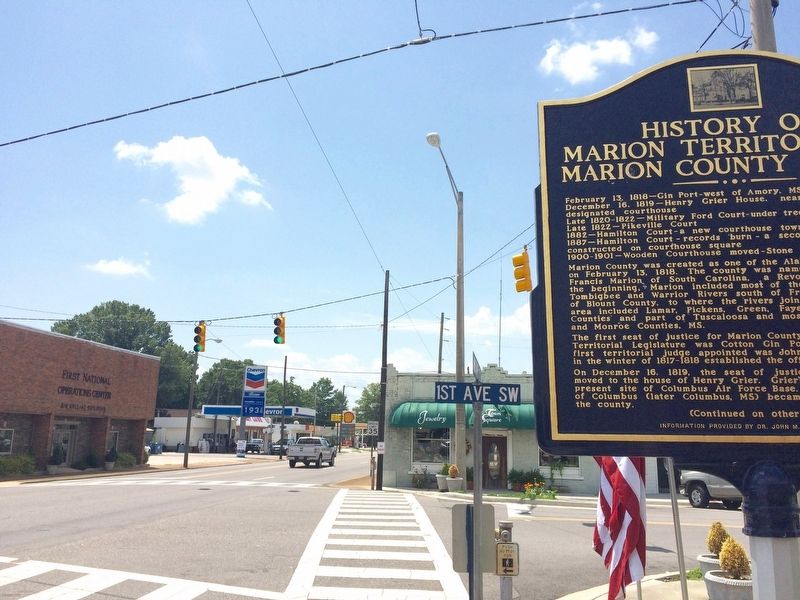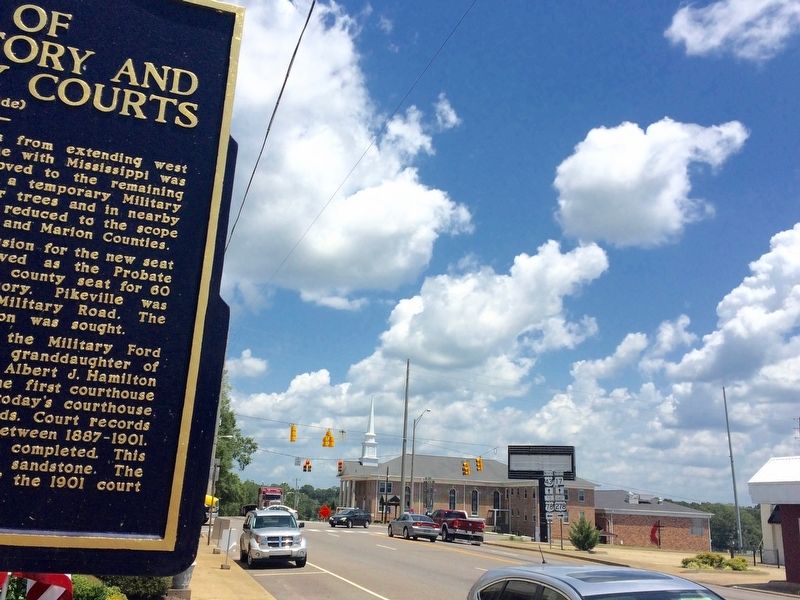Hamilton in Marion County, Alabama — The American South (East South Central)
History of Marion Territory and Marion County Courts
Inscription.
Side 1
February 13, 1818 — Gin Port - west of Amory, MS on Tombigbee River
December 16, 1819 — Henry Grier House, near Columbus, MS - first
designated courthouse
Late 1820-1822 — Military Ford Court - under trees and in Terrell Homes
Late 1822 — Pikeville Court
1882 — Hamilton Court - a new courthouse town location
1887 — Hamilton Court - records burn - a second wooden courthouse
constructed on courthouse square
1900-1901 — Wooden Courthouse moved - Stone Courthouse constructed
Marion County was created as one of the Alabama Territory counties on February 13, 1818. The county was named in honor of General Francis Marion of South Carolina, a Revolutionary War hero. In the beginning, Marion included most of the territory between the Tombigbee and Warrior Rivers south of Franklin County and west of Blount County, to where the rivers join near Demopolis. Marion's area included Lamar, Pickens, Green, Fayette, Walker, and Winston Counties and part of Tuscaloosa and most of present-day Lowndes and Monroe Counties.
The first seat of justice for Marion County selected by the Alabama Territorial Legislature was Cotton Gin Port near Amory, MS. The first territorial judge appointed was John Dabney Terrell, Sr., who in the winter of 1817-1818 established the officialdom of Marion County.
On December 16, 1819, the seat of justice of Marion County was moved to the house of Henry Grier. Grier's house was located at the present site of Columbus Air Force Base. In 1819-20, the community of Columbus (later Columbus, MS) became the first "real town" in the county.
Side 2
When the Indian Treaties prohibited Alabama from extending west to the Tombigbee River, the present state line with Mississippi was established in 1820. County records were moved to the remaining Alabama portion of the county and established a temporary Military Ford Court in 1820-1822. Court was held under trees and in nearby Terrell homes. By 1820 the county had been reduced to the scope of present-day Lamar, Fayette, Walker, Winston and Marion Counties.
In 1820 Pikeville was selected by a State Commission for the new seat of justice. Judge John Dabney Terrell, Jr., served as the Probate Judge between 1830's-1880's. Pikeville served as county seat for 60 years, while suffering the loss of county territory. Pikeville was located on a narrow and isolated ridge of the Military Road. The settlement could not be expanded. A new location was sought.
In 1881 the Toll Gate Community located
around the Military Ford site was elected to be the next county seat. A granddaughter of Judge Terrell, Sr., Mary Hamilton and her husband Albert J. Hamilton donated 40 acres about a mile north of the Ford. The first courthouse was a wooden two-story structure that stood where today's courthouse stands. It burned in 1887 destroying valuable records. Court records have remained intact surviving another courthouse between 1887-1901. In 1901, the "Sandstone Clock Tower Courthouse" was completed. This courthouse was cement and brick, covered by local sandstone. The Courthouse was remodeled in 1960, but the walls of the 1901 courthouse remain intact.
Erected 2010 by Dr. John M. Allman III & Marion County Preservation Society.
Topics. This historical marker is listed in these topic lists: Government & Politics • Industry & Commerce • Notable Buildings • Settlements & Settlers. A significant historical date for this entry is February 13, 1818.
Location. 34° 8.51′ N, 87° 59.333′ W. Marker is in Hamilton, Alabama, in Marion County. Marker is at the intersection of Military Street South (U.S. 278) and 1st Avenue SW, on the right when traveling south on Military Street South. Touch for map. Marker is at or near this postal address: 123 Military Street South, Hamilton AL 35570, United States of America. Touch for directions.
Other nearby markers. At least 8 other markers are within 13 miles of this marker, measured as the crow flies. The First Alabama Cavalry (a few steps from this marker); Confederate Veterans Bicentennial Memorial (within shouting distance of this marker); Hamilton, Alabama (approx. 0.3 miles away); Toll Gate (approx. 2 miles away); The Hamilton Mounds Site (approx. 3.1 miles away); General Jackson's Military Road (approx. 4.7 miles away); Historical Pikeville (approx. 7.3 miles away); City of Guin, Alabama: The Early Years / The Storms of 1974 (approx. 12.9 miles away). Touch for a list and map of all markers in Hamilton.
Credits. This page was last revised on August 12, 2016. It was originally submitted on August 12, 2016, by Mark Hilton of Montgomery, Alabama. This page has been viewed 704 times since then and 77 times this year. Photos: 1, 2, 3, 4, 5. submitted on August 12, 2016, by Mark Hilton of Montgomery, Alabama.
